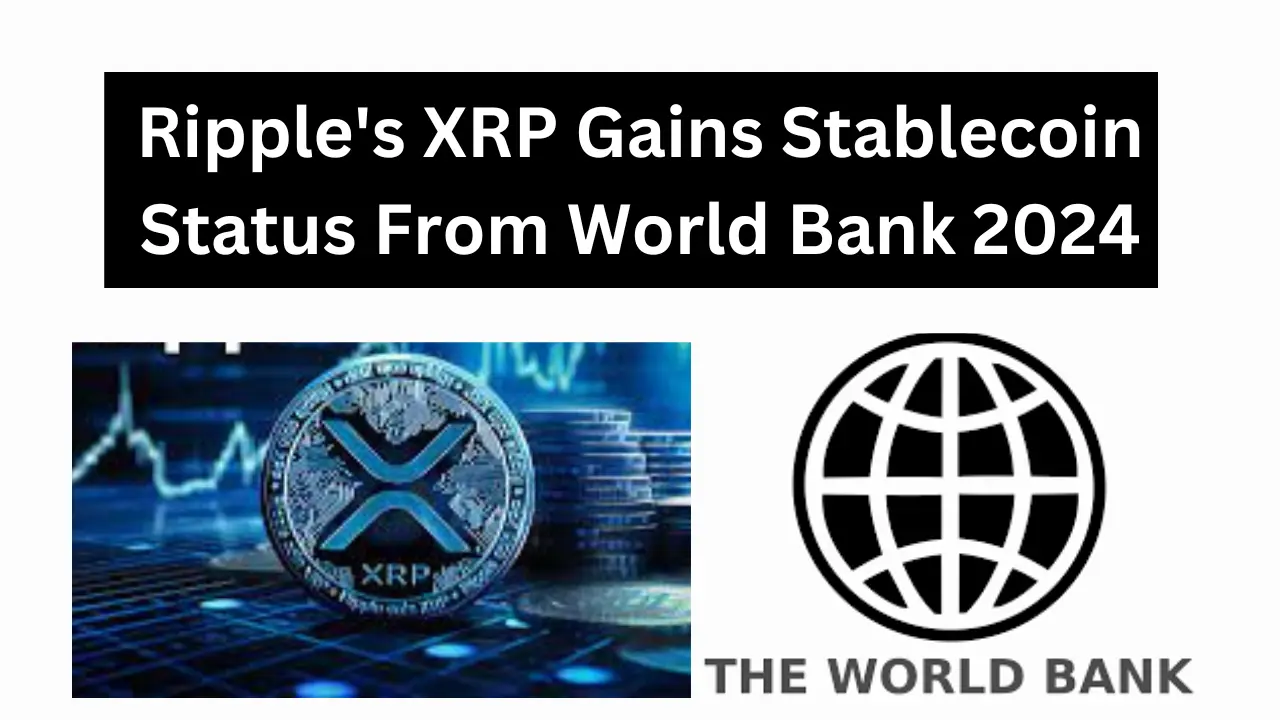Ripple’s XRP Gains The World Bank has recognized Ripple’s cryptocurrency, XRP, as a stablecoin, which is a big deal for Ripple. It shows that XRP is gaining acceptance globally and is seen as reliable for financial transactions.
This recognition means XRP is considered a stable and dependable digital currency, unlike some others that can be unpredictable. It’s good news because it makes XRP more appealing to businesses and banks worldwide.
Ripple focuses on making it easy to send money across borders quickly and cheaply. With this recognition, XRP can play a bigger role in making international transactions smoother and cheaper for everyone involved.
XRP’s Classification as a Stablecoin: A Clarification
The World Bank’s 2021 report reiterating XRP’s classification as a stablecoin has reignited discussions about its status. Ripple’s emphasis on Central Bank Digital Currencies (CBDCs) contrasts with XRP’s stablecoin label, prompting questions about its unfixed value and classification nuances.
Former Ripple director Sean McBride’s remarks and the World Bank’s stablecoin classification have sparked renewed interest, despite occurring over two years ago. This resurgence raises questions about the classification’s relevance today.
The return of discussions about XRP’s stablecoin potential, triggered by the World Bank’s 2021 report, invites reflections on its future trajectory. The classification suggests a potential shift from XRP’s current status.
Ripple’s focus on positioning XRP as a bridge currency between CBDCs may influence its decision not to introduce a stablecoin on the XRP Ledger (XRPL). This nuanced approach reflects Ripple’s evolving role in the digital asset landscape and the complex relationship between stablecoin classifications and broader financial systems.
A Throwback to the World Bank’s 2021 Report: Insights on XRP’s Classification
Resurfacing of World Bank’s 2021 Report: Fresh Insights on XRP’s Classification
The World Bank’s 2021 report dubbed “Central Bank Digital Currencies for Cross-Border Payments” categorized XRP as a stablecoin, sparking discussions about its role in the stablecoin ecosystem. However, attention waned as Ripple focused on XRP’s function as a bridge currency for cross-border payments.
In 2024, the classification has resurfaced, leading to new questions and renewed interest in XRP’s positioning:
Was the 2021 classification accurate?
The World Bank’s Global Financial Inclusion report labeled XRP as a “stablecoin” due to its price stability and fast transaction times. Unlike traditional stablecoins, XRP isn’t pegged to the US dollar. However, its relative stability since the report—despite a 50% decline—raises questions about the classification’s accuracy and prompts a deeper examination of XRP’s price dynamics.
Is this a hint of a future shift in XRP’s role?
Ripple consistently positions XRP as a bridge currency for cross-border payments, aiming to connect different Central Bank Digital Currencies (CBDCs). Some experts speculate that this objective might influence Ripple’s decision not to introduce its own stablecoin on the XRP Ledger (XRPL). This raises broader discussions about XRP’s utility and potential evolution within the digital currency landscape.
Why the sudden interest?
Recent discussions between Ripple supporter Wrath of Kahneman and former Ripple director Sean McBride reignited interest. McBride’s continued belief in XRP’s stablecoin potential, coupled with the renewed spotlight on the World Bank’s classification, fueled the conversation. This renewed attention underscores the evolving narratives surrounding XRP and its significance within the broader cryptocurrency community.
Unlocking XRP’s Evolution: Exploring its Potential Transformation
The World Bank’s Recognition: A Milestone for Ripple and XRP
The recent acknowledgment from the World Bank is a big deal for Ripple and XRP. It shows that XRP is gaining acceptance globally and is seen as a reliable bridge currency for cross-border transactions.
But there’s been some controversy around the World Bank’s stance. Some are wondering what it means, especially in light of XRPL’s possible plans to introduce a stablecoin.
Former Ripple director, McBride, believes in XRP’s usefulness and revealed that the World Bank sees it as a stablecoin. This could mean XRP might shift away from being pegged to the US dollar as Ripple’s cryptocurrency.
For more insights, check out Ripple News: XRP Community Questions Missing Ripple Stablecoin on XRPL. These discussions shed light on XRP’s changing role and its future in the digital currency landscape.
Ripple’s Long-term Strategy: A Fresh Perspective
The ongoing discussion raises questions about why Ripple hasn’t introduced a stablecoin on the XRPL in the past decade. Some speculate that Ripple’s goal of positioning XRP as a bridge currency between Central Bank Digital Currencies (CBDCs) could be influencing this decision.
Influencer Mr. Huber highlights Ripple’s view, considering private stablecoins as rival technologies and emphasizing XRP’s role as a bridge currency.
As debates persist about Ripple’s strategic direction, McBride’s support for XRP’s utility and the World Bank’s acknowledgment of its stability carry weight in ongoing discussions.
A Decade of Ripple: Navigating the Journey
